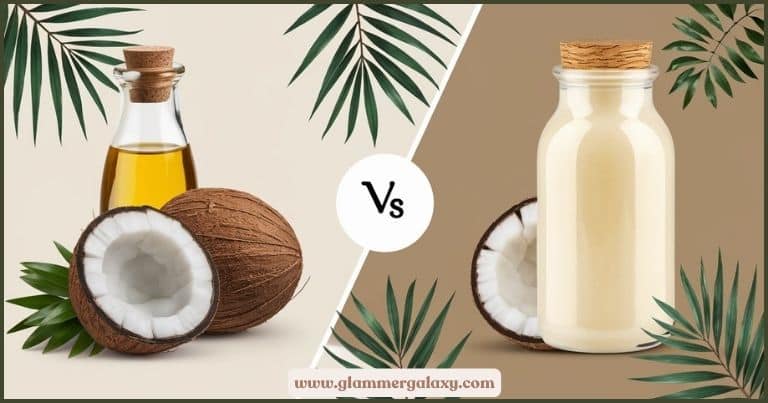In the world of natural hair care, coconut butter has emerged as a superstar ingredient. In this guide, we’ll explore the wonders of coconut butter for hair, how to make it at home, and three amazing DIY recipes that will revolutionize your hair care routine.
Coconut Butter vs. Coconut Oil: What’s the Difference?

Before we dive into the nitty-gritty of coconut butter for hair, let’s clear up a common confusion: the difference between coconut butter and coconut oil. While both come from the same source, they’re quite distinct in composition and uses.
Composition and Texture
Coconut butter is made from the whole coconut flesh, including the fiber. It’s creamy, thick, and spreadable at room temperature. The texture is similar to nut butter, with a slightly grainy feel due to the coconut fiber content. This unique texture makes it ideal for creating rich, nourishing hair treatments that can deeply penetrate the hair shaft.
On the other hand, coconut oil is extracted from coconut meat and contains only the fat portion. It’s liquid above 76°F (24°C) and solid below this temperature. Its consistency is smoother and more uniform than coconut butter, making it easier to apply evenly to hair. However, it lacks the additional nutrients found in coconut butter.
Nutritional Profiles
Here’s a quick comparison of the nutritional profiles:
| Nutrient | Coconut Butter | Coconut Oil |
| Fiber | High | None |
| Protein | Present | None |
| Fat | High | High |
| Vitamins | More varied | Limited |
| Minerals | More varied | Limited |
Coconut butter contains a wider array of nutrients due to its whole-food nature. The fiber content, in particular, sets it apart from coconut oil. This fiber not only adds texture but also contributes to the butter’s ability to retain moisture and provide a protective layer on the hair.
Benefits for Hair
While both coconut butter and oil offer benefits for hair, coconut butter has some unique advantages:
- More nutrients: The fiber and protein content in coconut butter provide additional nourishment for hair. These extra nutrients can help strengthen hair from within, leading to less breakage and improved overall hair health.
- Richer texture: Coconut butter’s thicker consistency makes it ideal for deep conditioning treatments. It can be easily applied to hair and scalp, allowing for better coverage and penetration.
- Longer-lasting moisture: The fiber in coconut butter helps lock in moisture for extended periods. This is particularly beneficial for those with dry or damaged hair, as it can help maintain hydration levels between washes.
- Scalp health: The additional nutrients in coconut butter can benefit the scalp, potentially helping with issues like dryness, flakiness, and even promoting hair growth.
- Versatility: Due to its rich composition, coconut butter can be used in various hair care applications, from pre-shampoo treatments to leave-in conditioners.
See Also : 20 Stunning Oval Nail Designs to Try Now
The Science Behind Coconut Butter for Hair
Understanding the science behind coconut butter’s effectiveness can help you appreciate its power in your hair care routine. Let’s delve deeper into the unique properties that make coconut butter a hair care superstar.
Fatty Acid Composition
Coconut butter is rich in medium-chain fatty acids (MCFAs), primarily lauric acid. This unique composition gives it several hair-friendly properties:
- Antimicrobial action: Lauric acid has natural antimicrobial properties, helping to keep the scalp healthy and free from fungal infections. This can be particularly beneficial for those prone to dandruff or other scalp conditions.
- Protein retention: MCFAs help prevent protein loss from hair, keeping it strong and reducing breakage. This is crucial for maintaining hair health, especially for those with chemically treated or heat-damaged hair.
- Moisture balance: The fatty acids in coconut butter help maintain the natural moisture balance of hair and scalp. They form a protective layer on the hair shaft, preventing excessive water loss while also allowing necessary moisture to penetrate the hair.
- Cuticle protection: The fatty acids in coconut butter can help smooth down the hair cuticle, reducing frizz and improving shine. This protective effect can also help prevent damage from environmental factors and styling.
Penetration Abilities
One of the most remarkable features of coconut butter is its ability to penetrate the hair shaft. Unlike many other oils and butter that simply coat the hair, coconut butter can actually enter the hair fiber. This means it can:
- Strengthen hair from within by reinforcing the hair’s internal structure
- Reduce protein loss during washing, helping to maintain hair strength over time
- Provide deep, long-lasting moisturization by hydrating the hair from the inside out
The penetrative ability of coconut butter is due to its molecular structure and composition. The medium-chain fatty acids, particularly lauric acid, have a straight linear chain structure that allows them to penetrate the hair shaft more easily than other oils with larger, more complex molecules.
Moisture Retention Properties
Coconut butter excels at moisture retention due to its unique composition:
- The fatty acids create a protective layer on the hair, locking in moisture. This barrier helps prevent water loss from the hair shaft, keeping it hydrated for longer periods.
- The fiber content acts as a humectant, attracting and retaining moisture from the environment. This property is particularly beneficial in humid conditions, as it can help hair maintain optimal moisture levels.
- Its emollient properties help smooth the hair cuticle, reducing moisture loss. A smoother cuticle means less friction between hair strands, which can lead to reduced breakage and frizz.
- The presence of vitamins and minerals in coconut butter can help improve the overall health of the hair, making it more receptive to moisture and better able to retain it.
How to Make Coconut Butter at Home
Making your own coconut butter is surprisingly simple and cost-effective. By creating it at home, you can ensure the purity of your product and customize it to your liking. Here’s a detailed guide on how you can make your own coconut butter:
Ingredients
- 4 cups unsweetened, dried coconut flakes (organic preferred)
When choosing your coconut flakes, opt for organic if possible. This ensures that your coconut butter is free from pesticides and other chemicals. Look for flakes that are fresh and have a strong coconut aroma for the best results.
Equipment Needed
- High-powered blender or food processor
- Spatula
- Glass jar for storage
A high-powered blender or food processor is crucial for achieving the right consistency. The powerful motor can break down the coconut flakes into a smooth, creamy butter. If you don’t have a high-powered appliance, you may need to blend for longer and take more frequent breaks to prevent overheating.
Step-by-Step Process
- Pour the coconut flakes into your blender or food processor. Make sure not to overfill – the coconut flakes should have room to move around freely.
- Blend on high speed for 10-15 minutes. Stop occasionally to scrape down the sides. This ensures all the coconut flakes are evenly processed.
- Be patient: The coconut will go through several stages – from floury to clumpy to creamy. Don’t be tempted to add any oil or liquid; the coconut will release its own oils as it’s processed.
- Continue blending until you achieve a smooth, buttery consistency. The time this takes can vary depending on your equipment and the freshness of your coconut flakes.
- Transfer the warm coconut butter to a glass jar. Be careful, as the friction from blending can make the butter quite warm.
- Let it cool at room temperature. It will solidify as it cools, typically taking a few hours to reach its final consistency.
Tips for Perfect Consistency
- Use room temperature coconut flakes for best results. Cold flakes may take longer to release their oils.
- If your blender starts to heat up, give it short breaks to cool down. This prevents overheating and ensures a smooth blending process.
- For a smoother butter, you can strain it through a fine-mesh sieve after blending. This removes any remaining small pieces of coconut, resulting in an ultra-smooth butter.
- If you live in a warm climate, you may need to store your coconut butter in the refrigerator to maintain its solid consistency. Just remember to let it come to room temperature before use for easier application.
“Making your own coconut butter allows you to control the quality and purity of the product, ensuring you’re getting the best possible benefits for your hair.” – Dr. Anita Patel, Trichologist
3 DIY Coconut Butter Hair Recipes
Now that you’ve got your coconut butter ready, let’s explore three amazing DIY recipes that will transform your hair care routine. These recipes are designed to address different hair needs and can be easily customized based on your hair type and concerns.
Nourishing Coconut Butter Hair Cream
This luxurious hair cream is perfect for daily use, especially for those with dry or damaged hair. It provides intense moisture while helping to smooth frizz and add shine.
Ingredients
- 1/2 cup coconut butter
- 2 tablespoons argan oil
- 1 tablespoon jojoba oil
- 5 drops lavender essential oil (optional)
Ingredient Benefits:
- Argan oil: Rich in vitamin E and fatty acids, it helps moisturize and protect hair from damage.
- Jojoba oil: Similar to our scalp’s natural sebum, it helps balance oil production and moisturize without greasiness.
- Lavender essential oil: Known for its soothing properties and pleasant scent.
Preparation Method
- Melt the coconut butter in a double boiler or microwave until just liquid. Be careful not to overheat, as this can damage the nutrients.
- Whisk in the argan and jojoba oils until well combined. This creates a smooth, homogeneous mixture.
- Add the lavender essential oil if using, and mix well. The essential oil adds a pleasant scent and may have additional benefits for scalp health.
- Pour into a clean jar and let cool completely. It will solidify into a creamy consistency. This process may take a few hours.
Application Technique
- Take a small amount and warm it between your palms. This helps the cream spread more easily through your hair.
- Apply to damp or dry hair, focusing on the ends and mid-lengths. These areas tend to be drier and more prone to damage.
- Style as usual. The cream can help smooth flyaways and add shine to your finished style.
Benefits for Different Hair Types
- Dry hair: Deep moisturization and frizz control. The combination of oils helps to seal in moisture and smooth the hair cuticle.
- Damaged hair: Protein retention and cuticle smoothing. The coconut butter helps prevent protein loss, while the added oils nourish and protect.
- Curly hair: Definition enhancement and moisture lock-in. This cream can help define curls while keeping them hydrated and frizz-free.
Explore this interesting article : Showering After an Ice Bath Myth or Necessity
Deep-Conditioning Coconut Butter Hair Mask
This intensive treatment is ideal for weekly use to restore and rejuvenate your hair. It’s particularly beneficial for those with dry, damaged, or chemically treated hair.
Ingredients
- 1/4 cup coconut butter
- 2 tablespoons honey
- 1 tablespoon apple cider vinegar
- 1 egg yolk (optional, for extra protein)
Ingredient Benefits:
- Honey: A natural humectant that helps attract and retain moisture in the hair.
- Apple cider vinegar: Helps balance pH levels and add shine to hair.
- Egg yolk: Rich in proteins and fats that can help strengthen and nourish hair.
Mixing Instructions
- Melt the coconut butter until just liquid. This makes it easier to mix with other ingredients.
- Whisk in the honey and apple cider vinegar until well combined. The mixture may look slightly separated at first, but keep whisking until it’s smooth.
- If using, add the egg yolk and mix thoroughly. Be sure to incorporate it fully to ensure even distribution of nutrients.
Application and Processing Time
- Apply the mask to damp hair, focusing on the scalp and working through to the ends. Using damp hair helps the mask penetrate more effectively.
- Massage gently to ensure even distribution. This also helps stimulate blood flow to the scalp, which can promote healthier hair growth.
- Cover with a shower cap or warm towel. This helps retain heat, which can enhance the mask’s effectiveness.
- Leave on for 30-60 minutes. The longer you leave it, the more time the nutrients have to penetrate your hair.
Rinse-Out Procedure
- Rinse thoroughly with lukewarm water. Make sure to remove all traces of the mask to prevent buildup.
- Shampoo and condition as usual. You may find you need less conditioner than normal due to the mask’s moisturizing effects.
Frequency of Use for Optimal Results
- For normal to dry hair: Use once a week
- For very dry or damaged hair: Use twice a week
- For oily hair: Use once every two weeks
Leave-In Coconut Butter Hair Conditioner
This lightweight leave-in conditioner is perfect for daily moisture and protection. It’s suitable for all hair types and can be especially beneficial for those with frizz-prone or heat-styled hair.
Ingredients
- 1/4 cup coconut butter
- 1/4 cup aloe vera gel
- 2 tablespoons rose water
- 5 drops rosemary essential oil
Ingredient Benefits:
- Aloe vera gel: Moisturizes and soothes the scalp while adding shine to hair.
- Rose water: Helps balance pH and adds a delightful scent.
- Rosemary essential oil: May promote hair growth and improve scalp health.
Blending Process
- Melt the coconut butter until just liquid. This makes it easier to blend with the other ingredients.
- In a blender, combine all ingredients and blend until smooth and creamy. The blending process helps emulsify the ingredients, creating a smooth, even consistency.
- Transfer to a spray bottle or pump dispenser. This makes application easier and more convenient for daily use.
Application Tips
- Shake well before each use. The ingredients may separate slightly over time.
- Spray or pump a small amount into your palm. Start with less than you think you need – you can always add more if necessary.
- Apply to damp hair, focusing on mid-lengths and ends. These areas tend to be drier and can benefit most from the leave-in conditioner.
- Comb through for even distribution. This helps ensure all your hair benefits from the conditioner.
Styling Suggestions
- Perfect for air-drying or as a pre-styling treatment. It can help enhance your hair’s natural texture when air-drying.
- Can be used on dry hair to tame frizz and add shine. Just use a very small amount to avoid weighing down your hair.
Maximizing the Benefits of Coconut Butter for Hair
To get the most out of your coconut butter hair treatments, consider these best practices and tips for incorporating it into your hair care routine.
Best Practices for Application
- Start with clean hair: Always apply coconut butter treatments to freshly washed hair for best absorption. This ensures that the nutrients can penetrate the hair shaft without being blocked by buildup or excess oils.
- Use on damp hair: Slightly damp hair allows for better distribution and absorption of the coconut butter. The moisture helps the coconut butter spread more evenly and can enhance its penetration into the hair shaft.
- Focus on problem areas: Pay extra attention to dry ends, frizzy sections, or areas prone to breakage. These parts of your hair often need more nourishment and can benefit greatly from the moisturizing and strengthening properties of coconut butter.
- Don’t overuse: A little goes a long way. Start with small amounts and increase as needed. Using too much can lead to greasy-looking hair or buildup over time.
- Be consistent: Regular use of coconut butter in your hair care routine will yield the best results. Consistency is key in seeing improvements in hair health and appearance.
Combining with Other Natural Ingredients
Coconut butter pairs well with many natural ingredients to enhance its benefits. Here are some combinations to try:
- Avocado: Adds extra moisture and vitamins. Mash half an avocado and mix it with 2 tablespoons of coconut butter for a nutrient-rich hair mask.
- Shea butter: Provides additional nourishment and softness. Mix equal parts coconut butter and shea butter for a super-moisturizing treatment.
- Essential oils: Can address specific hair concerns. Here are some options:
- Rosemary for growth
- Tea tree for scalp health
- Lavender for soothing the scalp
- Peppermint for stimulating the scalp
- Honey: Acts as a humectant and adds shine. Mix 1 tablespoon of honey with 2 tablespoons of coconut butter for a moisturizing hair mask.
- Yogurt: Adds protein and probiotics. Mix 1/4 cup of plain yogurt with 2 tablespoons of coconut butter for a strengthening treatment.
Precautions and Potential Side Effects
While coconut butter is generally safe for most people, be aware of these potential issues:
- Allergies: If you’re allergic to coconuts, avoid using coconut butter. Always do a patch test before applying new products to your hair or scalp.
- Buildup: Overuse can lead to product buildup. Use a clarifying shampoo periodically (every 2-4 weeks, depending on usage) to remove any residue.
- Greasiness: If your hair feels greasy, you may be using too much. Adjust the amount as needed, starting with less and increasing gradually.
- Protein sensitivity: Some people’s hair reacts negatively to too much protein. If you notice your hair becoming stiff or brittle, reduce the frequency of coconut butter treatments.
- Scalp irritation: While rare, some people may experience scalp irritation. If you notice any redness, itching, or discomfort, discontinue use and consult a dermatologist.
You might like reading : 25 Stunning Daisy Nail Designs for a Fresh Look
Coconut Butter for Specific Hair Concerns
Coconut butter can address a variety of hair concerns. Here’s how to use it for specific issues:
Addressing Dryness and Frizz
Coconut butter’s moisturizing properties make it excellent for combating dryness and frizz:
- Use as a pre-shampoo treatment to prevent moisture loss during washing. Apply coconut butter to dry hair, focusing on the ends, and leave for 30 minutes before shampooing.
- Apply a small amount to dry ends daily to tame frizz and add shine. Warm a pea-sized amount between your palms and smooth over the ends of your hair.
- Create a leave-in conditioner by mixing 1 tablespoon of coconut butter with 1/2 cup of water in a spray bottle. Shake well before each use and spritz on damp hair.
Combating Hair Breakage
The protein-retaining properties of coconut butter help strengthen hair and reduce breakage:
- Use a coconut butter mask weekly to fortify hair strands. Mix 2 tablespoons of coconut butter with 1 egg for added protein, apply to hair, leave for 30 minutes, then shampoo as usual.
- Apply a small amount to the lengths of your hair before using heat styling tools for protection. This creates a barrier between your hair and the heat, reducing damage.
- For severely damaged hair, try an overnight treatment. Apply coconut butter to dry hair, focusing on damaged areas, cover with a shower cap, and rinse out in the morning.
Promoting Scalp Health
Coconut butter’s antimicrobial properties can help maintain a healthy scalp:
- Massage a small amount into your scalp weekly to combat dandruff and dryness. The antimicrobial properties can help fight the fungus that often causes dandruff.
- Use a coconut butter-based scalp treatment to soothe irritation and promote blood circulation. Mix 2 tablespoons of coconut butter with 5 drops of tea tree oil and 5 drops of peppermint oil for a refreshing and soothing scalp treatment.
- For dry, flaky scalp, try a weekly coconut butter and honey mask. Mix equal parts coconut butter and honey, apply to the scalp, leave for 30 minutes, then shampoo as usual.
Enhancing Hair Growth
While coconut butter doesn’t directly cause hair growth, it can create an optimal environment for growth:
- Regular scalp massages with coconut butter can stimulate blood flow to hair follicles. This increased circulation can promote healthier, faster hair growth.
- Its nourishing properties help maintain healthy hair, preventing breakage and promoting length retention. Healthier hair is less likely to break, allowing you to retain length more easily.
- Create a growth-promoting oil blend by mixing coconut butter with other growth-stimulating oils like castor oil and rosemary oil. Use this blend for regular scalp massages.
Buying Guide: Choosing the Right Coconut Butter
If you prefer to buy coconut butter rather than make it at home, here’s what to look for:
What to Look for on Labels
- 100% coconut: Ensure coconut is the only ingredient listed. Avoid products with added oils, sugars, or preservatives.
- Organic: Choose organic to avoid pesticides and chemicals. This ensures you’re getting the purest form of coconut butter possible.
- Raw or cold-pressed: These methods preserve more nutrients. Heat processing can destroy some of the beneficial components of coconut butter.
- No additives: Avoid products with added sugars, oils, or preservatives. These can dilute the benefits of the coconut butter and may introduce unwanted ingredients to your hair care routine.
- Glass packaging: Preferably choose products packaged in glass jars. This helps preserve the quality of the coconut butter and is more environmentally friendly.
Organic vs. Conventional Options
Organic coconut butter is often preferred because:
- It’s free from pesticides and chemical fertilizers. This means you’re not introducing these potentially harmful substances to your hair and scalp.
- It may have a higher nutrient content. Organic farming practices can lead to more nutrient-dense produce.
- It’s better for the environment and often supports sustainable farming practices. Choosing organic supports eco-friendly agriculture.
However, conventional coconut butter can still be beneficial if it’s pure and high-quality. If organic options are not available or are significantly more expensive, a high-quality conventional coconut butter can still provide many benefits for your hair.
Price Comparison and Value for Money
Prices can vary widely depending on brand, quality, and whether it’s organic. Here’s a general guide:
| Type | Price Range (per 16 oz jar) | Value Considerations |
| Conventional | $10 – $15 | More affordable, still beneficial if pure |
| Organic | $15 – $25 | Higher quality, may have more nutrients |
| Artisanal | $20 – $30+ | Often highest quality, supports small businesses |
Remember, a little coconut butter goes a long way, so even pricier options can be cost-effective in the long run. Consider how often you’ll use the coconut butter and how much you typically need for each application when evaluating the value for money.
When choosing between brands, also consider:
- Brand reputation: Look for brands known for their quality and ethical practices.
- Customer reviews: These can provide insight into the product’s effectiveness and consistency.
- Certifications: Look for organic certifications, fair trade labels, or other quality assurances.
- Sourcing: Some brands provide information about where their coconuts are sourced, which can be an indicator of quality.
FAQs
Is coconut butter suitable for all hair types?
Yes, coconut butter can benefit most hair types. However, those with very fine or naturally oily hair should use it sparingly to avoid weighing down the hair. Here’s a breakdown by hair type:
- Dry hair: Ideal, provides deep moisturization
- Curly hair: Excellent for defining curls and reducing frizz
- Damaged hair: Great for repairing and strengthening
- Fine hair: Use sparingly, focus on ends
- Oily hair: Best as a pre-shampoo treatment
How often should I use coconut butter on my hair?
This depends on your hair type and needs:
- Dry or damaged hair: 2-3 times a week
- Normal hair: 1-2 times a week
- Oily hair: Once a week or as a pre-shampoo treatment
Start with less frequent applications and increase as needed based on how your hair responds.
Can coconut butter help with dandruff?
Yes, coconut butter’s antimicrobial properties can help combat dandruff-causing fungi. Regular scalp treatments with coconut butter may help reduce dandruff. For best results:
- Warm the coconut butter slightly for easier application
- Massage into the scalp thoroughly
- Leave on for at least 30 minutes before washing
- Use consistently for several weeks to see improvements
Is it possible to overuse coconut butter?
Yes, using too much coconut butter can lead to buildup and greasy-looking hair. Signs of overuse include:
- Hair feeling heavy or weighed down
- Increased oiliness at the roots
- Dull appearance
- Difficulty styling
Start with small amounts and adjust based on your hair’s needs. If you notice any of these signs, reduce the frequency or amount of coconut butter you’re using.
How long does homemade coconut butter last?
Properly stored in an airtight container in a cool, dry place, homemade coconut butter can last up to 6 months. To maximize shelf life:
- Use clean, dry utensils when scooping out the butter
- Keep away from direct sunlight and heat
- Check for any signs of rancidity (off smell, discoloration) before use
If refrigerated, it can last even longer, but may become very hard. Let it come to room temperature before use for easier application.
Conclusion
Coconut butter is a powerhouse ingredient for hair care, offering a multitude of benefits from deep moisturization to strengthening and scalp health. By incorporating coconut butter into your hair care routine, whether through store-bought products or DIY recipes, you can transform your hair from ordinary to extraordinary.
Remember, the key to success with coconut butter is finding the right balance for your specific hair type and needs. Don’t be afraid to experiment with different applications and recipes to discover what works best for you. Start with small amounts and adjust as necessary, paying attention to how your hair responds.
Some key takeaways to keep in mind:
- Coconut butter is more nutrient-dense than coconut oil, offering additional benefits for hair health.
- Its unique composition allows it to penetrate the hair shaft, providing deep nourishment.
- Regular use can help combat dryness, frizz, and breakage while promoting overall hair health.
- DIY recipes allow you to customize treatments to your specific hair needs.
- When purchasing coconut butter, look for pure, organic options for the best results.

Sarah Williams is an experienced blogger and fashion enthusiast at Glammer Galaxy. With a passion for beauty and style, she shares expert insights on hair trends, nail art, and fashion tips. Her creative flair and years of experience make her a go-to source for all things glam!







